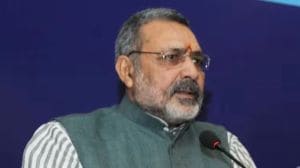Naxals up, Govt deeper in the Red
The Govt response so far has been to pour in ‘‘development’’ funds. To pour money into areas that are no longer in the state’s control is to pour money down the drain.

Last week I saw my first Naxalite document in the office of a think tank called the Institute of Conflict Management. It chilled me to the core of my being. Not just because of the Maoist revolution being planned in India, along the brutal lines of what we have seen in Nepal, but also because I cannot think of any government in India that could produce a paper as efficient or methodical. Certainly not the governments that rule in the Naxalite-infested states.
The document I saw contained a strategy to expand Naxalite activities and in it were details you would not find in a census by the Government of India. Details of caste, class and economic status of every household in the villages in which the expansion was planned. Detailed economic and political information and even details of temples and mutts and the kind of priests who ran them. Were they good priests or bad ones, did the community love them or not. Ajay Sahni, whom I consider one of our best informed experts on terrorism in South Asia, said there were thousands of such secret documents around so the Home Ministry must have seen them. In which case, why is it doing nothing?
For the same reason that it is not really doing much to fight the jihadis. We have a weak, dithering government in Delhi and an opposition that is looking increasingly ridiculous. To see aged BJP leaders banging pots and pans in the streets of Delhi like hysterical housewives was for me the last straw. We cannot expect anything from the mighty Hindu nationalist party. The BJP party is over.
So, I write this in the hope that either the Prime Minister or the ‘‘high command’’ notices that between the jihadis and the Naxalites we face a situation in which the very existence of India is under threat. If you think I am being alarmist, read on.
In the areas where the Naxalites operate there is no such thing as government or the authority of the state. Policing is so minimal that where the national average is 123 policemen for 100,000 people, in Bihar the figure comes down to 56. Police stations, like health centres and schools, exist mostly in name. Policemen live and work in conditions that should be considered unfit for humans and use weapons that should no longer be considered weapons. On the other side we have highly motivated, Maoist combatants armed with the latest automatic weapons and driven by ruthless leaders who kill deserters. As in more violent parts of Africa, these shadowy leaders are now using children as young as 10 to fight their war against India.
There is not the slightest chance of the Indian state winning unless someone in Delhi wakes up to the fact that the Naxalite problem cannot any longer be dismissed as a state subject. The Prime Minister must personally get involved in making strategy and policy. The first thing that has to improve, and improve dramatically, is policing and intelligence. This can only happen when rural police stations begin to look like real police stations instead of rundown cattle sheds.
The second thing that has to improve is governance. Ajay Sahni believes that one of the reasons why the Naxalites have gone from strength to strength is that the Government’s only response so far has been to pour in ‘‘development’’ funds. To pour money into areas that are no longer in the state’s control is to pour money down the drain.
It should be spent instead on a massive development effort in the areas in which state control exists so that the contrast between the fruits of violence and the fruits of peace are emphasised. Hospitals, schools, health centres must work as they should. But, who am I to give advice when there are think tanks like the Institute of Conflict Management within shouting distance of Parliament.
Whenever the Naxalite problem is mentioned, there is usually reference to a ‘‘red corridor’’ that includes tracts of Bihar, Jharkhand, Chhatisgarh, Orissa, Maharashtra and Andhra Pradesh. Well, according to the Naxalite document I saw there are areas outside this corridor that are already under Naxalite influence and there is an action plan to target students in cities like Mumbai and Delhi.
What will happen then to our dream of becoming an economic superpower in 20 years? Will somebody in Delhi wake up?



- 01
- 02
- 03
- 04
- 05




























